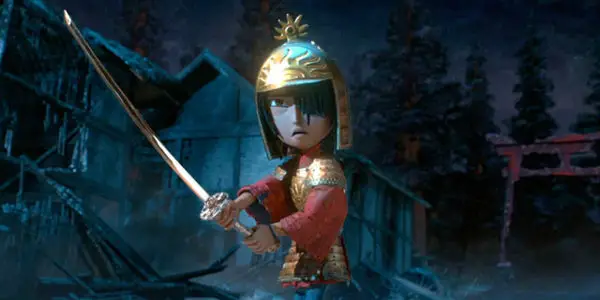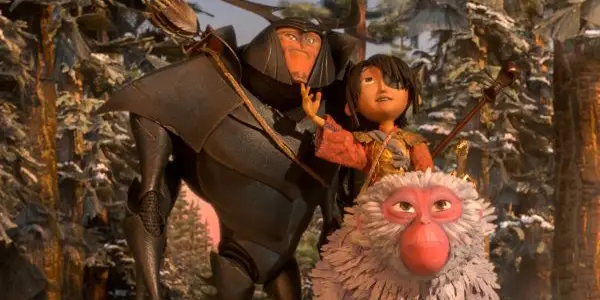Interview with KUBO AND THE TWO STRINGS Rotoscope & Digital Paint Artist Kaci Smith

A bi-product of passion and experimentation gone wrong, Mike has…
Kubo and the Two Strings ended up being my second favorite movie of 2016, just slightly behind Silence. It’s a gorgeous stop-motion animated film with a distinct voice and unrivaled aesthetics. The film has an insane amount of intellect and heart to backup the creative choices, and it pays-off with an incredibly effective story.
Set in feudal Japan, Kubo is a young boy with one eye who entertains the denizens of a nearby village with tall tales and mythic creatures, which are brought to life as origami by playing a magical guitar. One day, Kubo breaks his mother’s rule and stays out too late, bringing the forces of darkness down upon him and those he loves dearest. It’s up to Kubo to find a way to stop the evil and uncover the truth about human nature.
Produced by Laika, the company who also made Coraline, The Boxtrolls, and ParaNorman, Laika has truly become a force to be reckoned with. Kubo has been nominated for two Academy Awards in both Best Animated Feature and Best Visual Effects, only the second animated film in history to recieve a VFX nomination (A Nightmare Before Christmas was the first to do so back in 1993).

Seated in downtown Portland, Oregon, Laika studios is run by CEO Travis Knight, who made his directorial debut with Kubo. His vision is sound and fully materialized, equaling the epitome of what a piece of cinema can be. Yet for all his direction and ownership, there are hundreds of people who contributed to the look, sound, and execution of his film. I happen to be lucky enough to know one of those talented people, Kaci Smith, a rotoscope and digital paint artist, and was able to talk with her about her work on Kubo, her first full-length feature.
Mike Daringer for Film Inquiry: Kaci, Kubo, being the first major film you’ve worked on, what was it like? Was the experience surreal, or did it just kind of flow naturally from the animation you’d been doing for commercials?
Kaci Smith: Working on Kubo was completely different from any other job I have had. Some of the same basic mechanics are similar in the actual work itself, but the whole process was new to me. But Laika invests in their employees. Anytime I needed a little extra explaining or help, someone was there to do it. They made me feel great in the process. Everyone there helped to build me up and expand on what I had brought to the table.
One of the biggest differences is just that this is such an enormous and collaborative project. In commercial work, it’s 30 seconds and with a small team. There is also a real thrill in seeing your work in the wild. A lot of my commercial work is local stuff. Kubo and the Two Strings was an international release. People all over the world can see my name in the credits of this film. I would say that is pretty surreal.
I’m in the business so I know what rotoscope and digital paint are, your department is basically the unsung hero of animation and animation in live-action movies. I’m sure most people, and casual moviegoers, have no idea what rotoscoping and digital painting are. Can you enlighten us what you did at Laika for this project?
Kaci Smith: No one knows our department, because if our work was noticed, we didn’t do our job right! Specifically for stop-motion animation, the puppets have rigs to hold them into position while filming. With Laika’s stop-motion technique, there are seams in the faces because we 3D print portions of the faces for each frame. In the roto/paint department we digitally remove those things! We remove seams, rigs, and any little bits of dust that might have popped in. We basically take the footage, clean it up and do any last touches before it goes in the can.

Would you be kind enough to specifically define the difference between rotoscope and digital paint, or are they inseparable?
Kaci Smith: Rotoscoping is a technique of essentially separating an element from the footage. I digitally trace around an object and create what is called a matte so that the compositors can take that object and incorporate it into the scene. Sometimes you may roto around a foreground element so that you can change the color or style of the background. It is basically isolating an element to help along the compositing process.
Digital paint is a technique where you use similar processes as Photoshop to enhance the footage. If a piece of dust made it into frame, for instance, you can use the paintbrush tool to sample from another frame to remove it. Often these techniques are used together in removing rigs and seams. We also sometimes tackle what we call chatter. Chatter is when frame by frame things aren’t quite lining up the way they are supposed to. We digitally correct this, giving a more smoothed out finish.
Which exact scenes did you work on in Kubo?
Kaci Smith: I touched almost every scene in the movie. We are assigned shots, and sometimes even tackle them together, so my work is sprinkled through the entire thing.
Since animated movies take so long to make, did you ever get to see dailies or rough cuts of the scenes that you were doing? If so, what was it like seeing (or in this case not seeing) the work you had contributed?
Kaci Smith: Yes! When I was first hired I watched the entire movie in animatic form. I was so excited about such a beautiful story. About midway through production, Laika did a screening for all the employees to see how far we had come and how far we still had to go. That one was really crazy because we could actually see this thing taking shape. Every week they also screened all the completed work in a happy hour celebration, and that was always fun to see and socialize with other departments, too.
Just because I’m nosy, did you ever get to meet Laika CEO and Kubo director Travis Knight, or sit in on any pow-wow meetings with the heads of the departments?
Kaci Smith: I sat in the same room with him 1-3 times a week almost the whole duration of the film. He was such a great director to work with. He loved our work, and gives credit to those who have earned it. He always knew who to give credit to in difficult shots, and never hesitated to say thank you. He really makes you feel like a part of the team. He had a really great eye and vision and it all comes through in the finished work. With all of the award nominations and wins, Travis and other leadership have been very great about making sure we know that it’s a win for all of us.
Was there anything specific about the filmmaking and the craft that you have adopted to make you a better artist, whether it be a mindset or an actual technique?

Kaci Smith: Being in roto/paint has developed my eye for detail. I’m here to catch any little thing that needs a little smoothing over. It has transferred over into my personal work. I like to paint occasionally as a hobby, and have found that I am much more meticulous than I have been in the past.
Looking ahead, are there new animation jobs or positions you want to get into? Do you want to eventually become a lead animator, writer, producer, or director?
Kaci Smith: I’m not really sure where my path leads next. The natural progression is to typically move into comp from roto. The company seems to be continually growing, so there might be positions that come available. I’m just going to keep plugging away and see where it gets me.
Kubo and the Two Strings is available on DVD/Blu-Ray, and is available on-demand, ITunes, and Amazon streaming services.
Does content like this matter to you?
Become a Member and support film journalism. Unlock access to all of Film Inquiry`s great articles. Join a community of like-minded readers who are passionate about cinema - get access to our private members Network, give back to independent filmmakers, and more.
A bi-product of passion and experimentation gone wrong, Mike has spent most of his time in the field couch surfing and growing a comb-over. Several of his favorite films are Rashomon, Vertigo, Apocalypse Now, and The Naked Gun.













